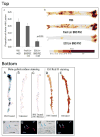Atherosclerosis, inflammation, genetics, and stem cells: 2012 update
- PMID: 22476914
- PMCID: PMC3537163
- DOI: 10.1007/s11883-012-0244-1
Atherosclerosis, inflammation, genetics, and stem cells: 2012 update
Abstract
Atherosclerosis is a peculiar form of inflammation triggered by cholesterol-rich lipoproteins and other noxious factors such as cigarette smoke, diabetes mellitus, and hypertension. Genetics also play an important role in the disease, accounting for about 40% of the risk. Of surprise in recent years of post-human genome sequencing, atherosclerosis-relevant genes discovered by non-biased techniques (ie, genome-wide association studies), did not rehash previously suspected pathways of lipid metabolism, diabetes, or hypertension. Instead these studies highlighted genes relevant to mechanisms of inflammation and stem cell biology. Only a minority of implicated genes were linked to lipid and other cardiac risk factor genes. Although such findings do not contradict the fact that atherosclerosis is triggered and exacerbated by elevated lipids, atherosclerosis "new genes" suggest that the mechanism responsible for the development of arterial lesions is more complex than a simple response to injury, where injury is necessary, but perhaps not sufficient, for disease progression.
Figures




Similar articles
-
Inflammation, stem cells and atherosclerosis genetics.Curr Opin Mol Ther. 2010 Dec;12(6):712-23. Curr Opin Mol Ther. 2010. PMID: 21154163 Review.
-
Endothelial NOTCH1 is suppressed by circulating lipids and antagonizes inflammation during atherosclerosis.J Exp Med. 2015 Nov 16;212(12):2147-63. doi: 10.1084/jem.20150603. Epub 2015 Nov 9. J Exp Med. 2015. PMID: 26552708 Free PMC article.
-
Bone morphogenic protein antagonists are coexpressed with bone morphogenic protein 4 in endothelial cells exposed to unstable flow in vitro in mouse aortas and in human coronary arteries: role of bone morphogenic protein antagonists in inflammation and atherosclerosis.Circulation. 2007 Sep 11;116(11):1258-66. doi: 10.1161/CIRCULATIONAHA.106.683227. Epub 2007 Sep 4. Circulation. 2007. PMID: 17785623
-
From Endothelium to Lipids, Through microRNAs and PCSK9: A Fascinating Travel Across Atherosclerosis.High Blood Press Cardiovasc Prev. 2020 Feb;27(1):1-8. doi: 10.1007/s40292-019-00356-y. Epub 2020 Jan 10. High Blood Press Cardiovasc Prev. 2020. PMID: 31925708 Review.
-
Role of PGC-1α in Vascular Regulation: Implications for Atherosclerosis.Arterioscler Thromb Vasc Biol. 2016 Aug;36(8):1467-74. doi: 10.1161/ATVBAHA.116.307123. Epub 2016 Jun 16. Arterioscler Thromb Vasc Biol. 2016. PMID: 27312223 Free PMC article. Review.
Cited by
-
A comparison of genome-wide DNA methylation patterns between different vascular tissues from patients with coronary heart disease.PLoS One. 2015 Apr 9;10(4):e0122601. doi: 10.1371/journal.pone.0122601. eCollection 2015. PLoS One. 2015. PMID: 25856389 Free PMC article.
-
Switching of vascular cells towards atherogenesis, and other factors contributing to atherosclerosis: a systematic review.Thromb J. 2020 Oct 28;18:28. doi: 10.1186/s12959-020-00240-z. eCollection 2020. Thromb J. 2020. PMID: 33132762 Free PMC article.
-
Are Endothelial Progenitor Cells the Real Solution for Cardiovascular Diseases? Focus on Controversies and Perspectives.Biomed Res Int. 2015;2015:835934. doi: 10.1155/2015/835934. Epub 2015 Oct 5. Biomed Res Int. 2015. PMID: 26509164 Free PMC article. Review.
-
The Role of Oxidative Stress in Cardiovascular Aging and Cardiovascular Diseases.Life (Basel). 2021 Jan 15;11(1):60. doi: 10.3390/life11010060. Life (Basel). 2021. PMID: 33467601 Free PMC article. Review.
-
Twenty-First Century Diseases: Commonly Rare and Rarely Common?Antioxid Redox Signal. 2017 Sep 20;27(9):511-516. doi: 10.1089/ars.2017.7065. Epub 2017 Jul 5. Antioxid Redox Signal. 2017. PMID: 28482684 Free PMC article.
References
-
- Brown MS, Goldstein JL. Koch's postulates for cholesterol. Cell. 1992;71(2):187–188. - PubMed
-
- Libby P, Ridker PM, Hansson GK. Progress and challenges in translating the biology of atherosclerosis. Nature. 2011;473(7347):317–25. Review. • This is a thorough review of the most recent information on atherosclerosis inflammation and its cellular and molecular agents. Novel clinical trials with anti-inflammatory drugs are also surveyed. - PubMed
-
- Ridker PM, Rifai N, Rose L, Buring JE, Cook NR. Comparison of C-reactive protein and low-density lipoprotein cholesterol levels in the prediction of first cardiovascular events. N Engl J Med. 2002;347(20):1557–1565. - PubMed
-
- American Heart Association. [Accessed December 2011.];Heart Attack Risk Calculator. Available at: https://www.heart.org/gglRisk/locale/en_US/index.html?gtype=health.
Publication types
MeSH terms
Grants and funding
LinkOut - more resources
Full Text Sources
Other Literature Sources
Medical

